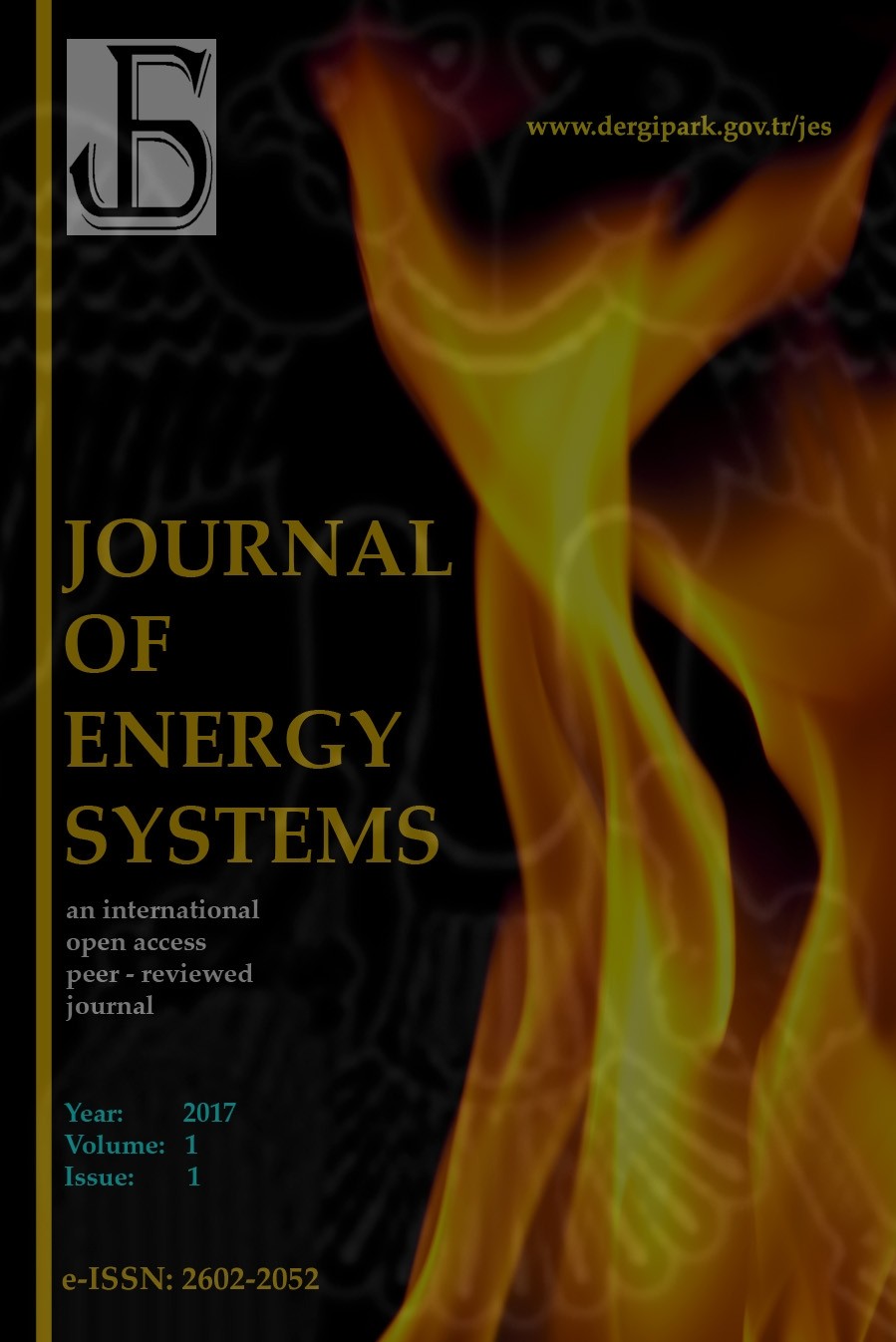Development and performance evaluation of a self-sustaining electric generator with automatic control
Development and performance evaluation of a self-sustaining electric generator with automatic control
___
- [1] Straub, S., Terada-Hagiwara, A. Infrastructure and Growth in Developing Asia. In: Son, H.H. editor. Asian Development Bank Economics Working Paper Series No. 231. Manila, Philippines. Asian Development Bank, 2011. doi:https://dx.doi.org/10.2139/ssrn.1783168.
- [2] Asghar, Z. Energy–Gdp Relationship: A Causal Analysis For The Five Countries Of South Asia. In: Applied Econometrics and International Development; 9(1): Santiago de Compostela, Spain. Applied Econometrics and International Development (AEID), 2008. pages 167-180.
- [3] Gallardo, S. Air Pollution Studies in Metro Manila and Catalysis Technology Towards Clean Air Philippines. In: Rao, G., Raman, S., Siggh, M. (eds) Air Quality. Pageoph Topical Volumes. 2003. Birkhäuser, Basel. doi: https://doi.org/10.1007/978-3-0348-7970-5_20.
- [4] Yuan, Z., Shouyang, W., Fengchun, S., Xiaosong, H., Yaojung S. Large-scale deployment of electric taxis in Beijing: a real-world analysis. Energy 2016; 100: 25–39. doi:https://doi.org/10.1016/j.energy.2016.01.062.
- [5] Zhenhe, L., Amir K., Jinchun S. A comprehensive review of the key technologies for pure electric vehicles. Energy 2019; 182: 824–839. doi:https://doi.org/10.1016/j.energy.2019.06.077.
- [6] William, C., Xiaogang, W., Minghao, Z., Yafei, L. Yujin W. Review and Development of Electric Motor Systems and Electric Powertrains for New Energy Vehicles. Automot. Innov. 2021; 4: 3–22. doi:https://doi.org/10.1007/s42154-021-00139-z.
- [7] Houda B., Rachid D. A Study of a DC/AC Conversion Structure for Photovoltaic System Connected to the Grid with Active and Reactive Power Control. Complexity 2021: 9967577. doi:https://doi.org/10.1155/2021/9967577.
- [8] Roman, E., Alonso, R., Ibañez, P., Elorduizapatarietxe, S., Goitia, D. Intelligent PV module for grid-connected PV systems. EEE Transactions on Industrial Electronics 2006; 53: 1066–1073. doi: https://doi.org/10.1109/TIE.2006.878327.
- [9] Prakash, K., Churchill, S., Smyth, R. Petrol prices and subjective wellbeing. Energy Economics 2020; 90: 104867. doi:https://doi.org/10.1016/j.eneco.2020.104867.
- [10] Endresen, Ø. , Sørgård, E., Sundet, J., Dalsøren, S., Isaksen, I., Berglen, T., Gravir, G. Emission from international sea transportation and environmental impact. Journal of Geophysical Research Atmospheres 2003; 108. doi:https://doi.org/10.1029/2002JD002898
- [11] Sornek, K., Wiercioch, J., Kurczyna, D., Wójcik R., Borowicz, M., Wieliński, M. Development of a solar-powered small autonomous surface vehicle for environmental measurements. Energy Conversion Management 2022; 267: 115953. doi: https://doi.org/10.1016/j.enconman.2022.115953.
- [12] Pang, Y., Cao, Y., Derakhshani, M., Fang, Y., Wang, Z., Cao, C. Hybrid Energy-Harvesting Systems Based on Triboelectric Nanogenerators. Matter 2021; 4: 116-143. doi: https://doi.org/10.1016/j.matt.2020.10.018.
- [13] Miller, A. Electronic circuits to extend battery life time. US Patent US9441799B2. 2015.
- [14] Wang, T., Zhou, Z. A Compact Hydrostatic-Driven Electric Generator: Design, Prototype, and Experiment. IEEE/ASME Transactions on Mechatronics, 2016; 21: 1612-1619. doi:https://doi.org/10.1109/TMECH.2015.2504491
- [15] Yuan, C., Feng, H., He, Y. An experimental research on the combustion and heat release characteristics of a free-piston diesel engine generator. Fuel 2017; 188: 390-400. doi:https://doi.org/10.1016/j.fuel.2016.10.057.
- [16] Yeh, C., Li-Yu. 2014. Developing the full-field wind electric generator. International Journal of Electrical Power and Energy Systems 2014; 55: 420-428. doi:https://doi.org/10.1016/j.ijepes.2013.09.030
- [17] Hartono, E., Golubev, M., Moradnia, P., Cher-noray, V., Nilsson, H. A PIV Study of The Cooling Air Flow in An Electric Generator Model. Sweden: Department of Applied Mechanics Chalmers University of Technology. 2012.
- [18] Nishanth, B., Kumar, D., Naveen, A., Vijayanandh, R., Senthil Kumar, M. Energy harvesting from a Gas Turbine Engines exhaust heat Using Quantum Well Thermo Electric materials Generator (QWTEG). Materials Today: Proceedings 2017; 4: 8378-8386. doi: https://doi.org/10.1016/j.matpr.2017.07.181.
- [19] Thirunavukkarasu, M., Sawle, Y. , Lala, H. A comprehensive review on optimization of hybrid renewable energy systems using various optimization techniques. Renewable and Sustainable Energy Reviews 2023; 176: 113192. doi: https://doi.org/10.1016/j.rser.2023.113192.
- [20] Jung, W., Lee, M., Kang, M., Moon, H., Yoon, S., Baek, S., Kang, C. Powerful curved piezoelectric generator for wearable applications. Nano Energy 2015; 13: 174-181. doi: https://doi.org/10.1016/j.nanoen.2015.01.051.
- [21] Takemata, K., Kodata, A., Minamide, A., Nakamira, S. Engineering project-based learning under the CDIO concept. In: IEEE International Conference on Teaching, Assessment and Learning for Engineering (TALE); 26-29 August 2013:. IEEE, Bali, Indonesia. pp. 258-261. doi: https://doi.org/10.1109/TALE.2013.6654442.
- Başlangıç: 2017
- Yayıncı: Erol KURT
Thermal analysis of phase change materials storage in solar concenter
Sulaiman AL HASHMİ, Mingjie CHEN
Electromagnetic shielding tests of a permanent magnet generator
Mehmet SARIKAHYA, Nihan Merve SARIKAHYA, Erol KURT
Quenching chaos in a power system using fixed-time fractional-order sliding mode controller
Abdul-basset A. AL-HUSSEİN, Fadhil RAHMA TAHİR
Modelling and optimization of residual stress induction on laser-worked X12Cr turbine blades
Festus Oluwadare FAMESO, Dawood DESAİ, Schalk KOK, Dylan ARMFİELD, Mark NEWBY
Denis CHİKURTEV, Veneta YOSİFOVA, Milena HARALAMPİEVA, Rosen PETROV
